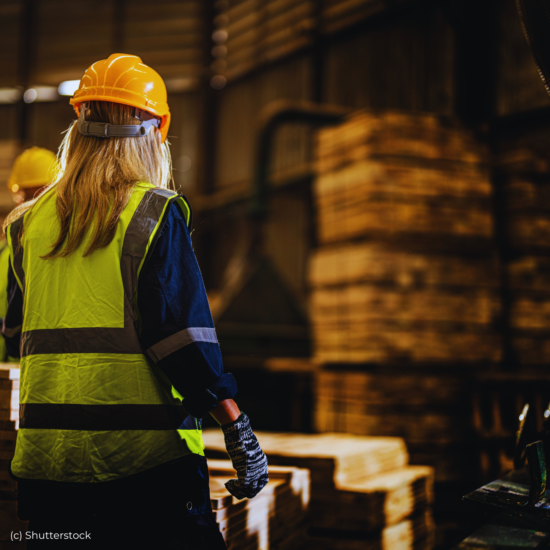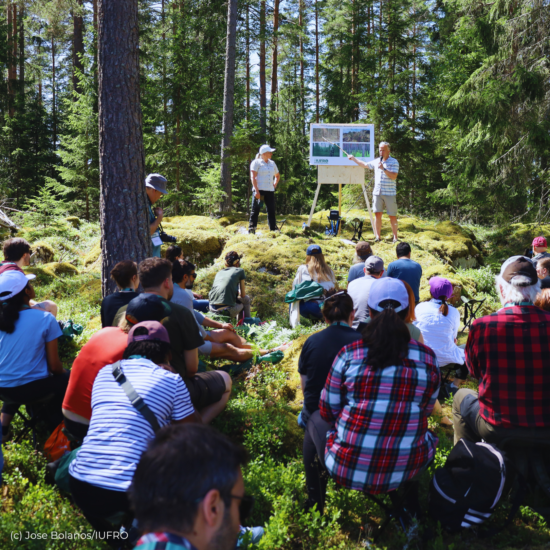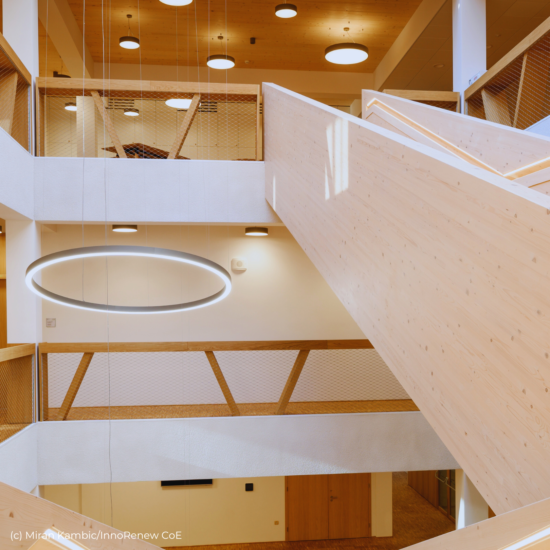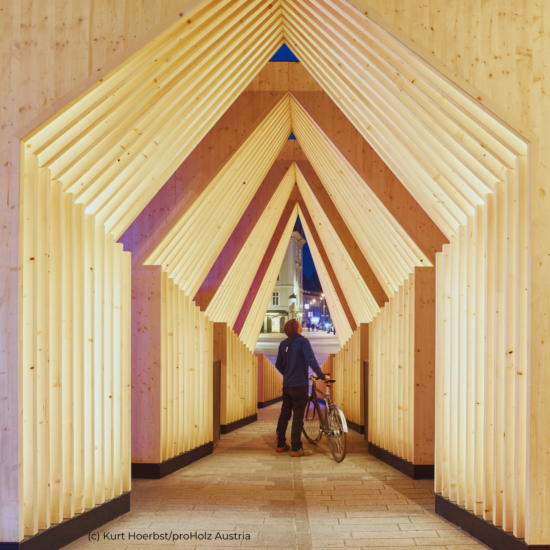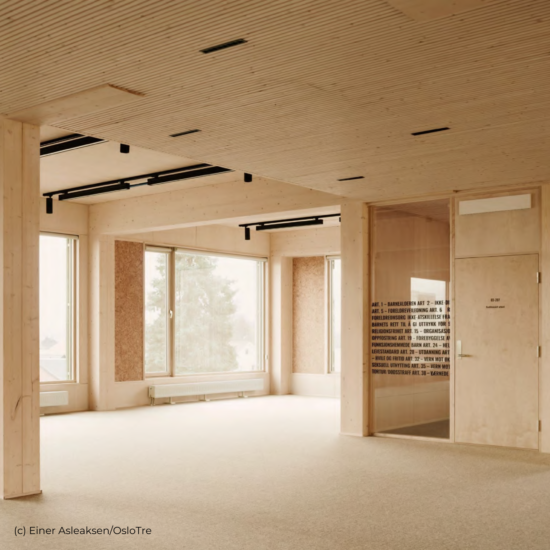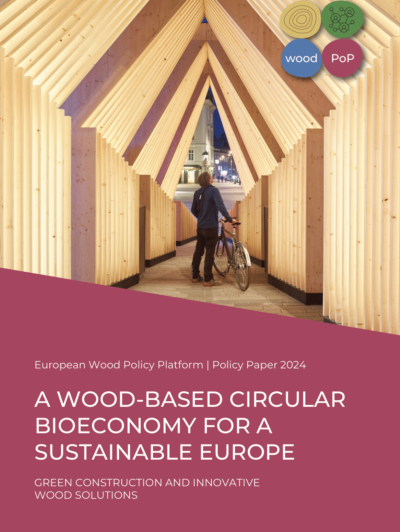
Publication Details
Category
WoodPoP Policy paper
Date
November 2024
(3rd High Level Meeting Version)
The Policy Paper provides the most important information and content to serve as a reference point for the political work of woodPoP members in political committees and individual discussions with ministries, parliaments, and the public.
The document identifies critical fields of action and the necessary structural short to long-term framework conditions, as well as suitable instruments and resources, for strengthening the wood-based circular bioeconomy in Europe.
This Policy Paper contributes to a joint understanding between public and private actors along the value chain for strengthening the wood-based circular bioeconomy in Europe with a special focus on the construction sector.
It identifies critical fields of action and the necessary structural short to long-term framework conditions, as well as suitable instruments and resources to this end.
This paper targets a pan-European audience on national and regional levels, integrating global perspectives, allowing it to reach beyond European borders. While particular focus is placed on the dialogue with European Union policy and decision-makers, the Policy Paper takes into account national, regional, sub-regional diversity and specific policy needs of the whole pan-European continent to foster the wood-based circular bioeconomy.
Engagement in the platform is voluntary and does not imply financial or legal commitments. It commits to supporting a sustainable wood policy at the pan-European level.
For the purpose of this Policy Paper, sustainable wood policy is understood as the following:
A sustainable wood policy integrates the principles of Sustainable Forest Management (SFM) into the wood-based value chain, ensuring a holistic approach from sustainable forest management to the end product meeting both present-day and future needs.
This policy encompasses environmentally sound practices, social responsibility, and economic viability throughout the entire process of timber production, processing, and distribution.
By considering sustainable forest management and the wood-based value chain, the policy aims to maintain forest health and biodiversity, support local economies, and promote the use of sustainably sourced wood products that contribute to a resilient and environmentally friendly wood-based circular bioeconomy.
- Europe’s wood, paper, and fibre-based industries and forests represent 527 billion euros of direct gross value added, 3.34% direct share of total economic output, and employ 7.9 million workers directly.
- When also direct, indirect and induced effects are considered, the total gross value-added increases to 1.114 billion euros, the economic output to 7.06% and jobs to 17.5 million, showing the importance of the sector to Europe, today and in the future.[1]
- The wood-based sector englobes the mobilisation and first transformation of wood, building and construction activities, production side streams, reuse and recycling aspects.[2]
- The wood-based sector is a key player in the transition towards a more innovative, inclusive, and sustainable society, specifically contributing to rural development and the job creation considering primary, secondary raw materials and off-site prefabrication.
[1] Econmove, Economica (2023) The economic impact of the forestry and wood industry in Europe in terms of bioeconomy, Vienna
[2] Definition used from the Wood Circus Project; www.woodcircus.eu
- Sustainable wood policies are based on the premise of sustainable forest management. These policies are the basis of supply for the material and energetic uses of the renewable resource: wood.
- Sustainable forest management aims to ensure that the forests supply goods and services meet both present day and future needs, contributing to the sustainable and inclusive development of communities.
- In addition to forest products (comprising of both wood and non-wood forest products), sustainably managed forests provide important ecosystem services, such as carbon sequestration, biodiversity conservation, recreation, well-being, cleaning of air, and the protection of water.
- To ensure balance between forest conservation and wood production, it is necessary to identify and differentiate between the various forest ecosystems in Europe, their characteristics, dynamics and contributions to tackling climate change and biodiversity loss.
- Wood plays a vital role in the transformation towards a carbon-neutral and circular bioeconomy and a climate-positive society.
- Wood and wood products are vital components for healthy, liveable and sustainable living and working spaces.
- Wood and wood-based products constitute a sustainable and aesthetic alternative to fossil-intensive and non-renewable products for many consumers.
- Circular thinking, eco-design, and actions in all stages of processing and service life, allowing the reuse of the relevant product system and its materials, are indispensable for the efficient use of wood as a renewable yet limited resource.
- Greening of urban areas with forests and wood buildings can improve the quality of living and to contribute to better air quality, heat reduction and well-being.
- There is a need to foster the use of wood from sustainably managed forests as well as woody biomass from other sources like e.g. farms or waste as renewable resources and to systematically integrate the wood-based value chain into the transition to a climate-neutral economy and society.
- Attention and public interest in the potential of wood, wood-based products, and the wood-based value chains should be further increased in the coming years.
- As a renewable resource, wood and wood-based products are an immediately available solution to help mitigate climate change by substituting fossil-intensive and non-renewable materials and fuels.
- Wood products are highly versatile, store carbon within their lifetime, and offer viable alternatives to materials such as concrete, steel, plastics, and synthetic fibres.
- Wood buildings store carbon throughout their life cycle, have the potential to reduce the use of energy for cooling and heating, and offer a positive impact on well-being and health.
- Wood is suitable for building and renovations of small to high-rise buildings, whether for private or public construction and therefore should play a crucial role in the European Renovation Wave.
- The possibilities for digital revolution, automation, pre-fabrication and utilization of artificial intelligence are countless.
- Wood encourages innovation and presents versatile uses. Its effects on health and well being, its mechanical, chemical, physical, and acoustic properties as well as its workability allow for numerous new solutions.
- Wood offers numerous opportunities for a circular bioeconomy. As a renewable yet limited resource, the efficient use of wood is essential. By applying the cascading principle where appropriate, resource efficiency and minimising waste can be achieved.
- The wood-based sector creates green jobs, livelihoods, and local development in urban and rural areas.
- Despite the outstanding sustainability and economic benefits of wood products, their market presence remains limited, with wood construction accounting for only 2-3% of the market share in Europe.
Therefore, targeted policy interventions are urgently needed to promote these sustainable practices and unlock the full potential of wood products in the market.
To sustainably source wood and promote transparency and traceability in the wood supply chain, we call on all relevant public and private actors to:
- Strengthen sustainable forest management, including reforestation, climate-adaption, biodiversity conservation and ecosystem resilience.
- Ensure the availability of wood resources for all wood-based industries, inter alia for industries producing long-lasting carbon cycles in wood-based products replacing fossil-intensive and non-renewable products.
- Increase social acceptance of mobilising wood as an integral part of the multifunctional role of sustainable forest management.
- Provide incentives (but avoid market distortion) and other public and private capital, as well as positive recognition for companies to further adopt responsible sourcing practices.
- Harmonize and simplify interdependencies of different regulations for timber mobilisation and timber trade (EUDR, Lacey Act, Japanese Clean Wood Act, RED III, etc.) and accommodate for substantial reduction in bureaucracy of the existing regulatory framework.
- Foster an integrated value chain approach connecting and supporting industry and forestry owners in the digitalisation of their operations, including the potential use of new technologies.
- Enhance the role of Information and Communication Technologies (ICT) and digitalisation in the forestry sector by implementing advanced technologies such as Artificial Intelligence (AI), Internet of Things (IoT), blockchain, and data analytics to improve traceability, optimise resource management, and streamline operations across the supply chain.
- Use and improve feasible transparency tools for materials delivered from wood, providing reliable information on available resources whilst investing in research and development along the entire value chains.
- Provide training for companies throughout the supply chain, including loggers, processors, traders, and retailers, on best practices for traceability.
- Support small-scale producers and suppliers, inter alia through capacity-building initiatives, to comply with regulatory and certification requirements, promoting inclusivity and fairness in the supply chains.
To improve resource efficiency and circularity, we call on all public and private relevant actors to:
- Create an environment that supports circular thinking, eco-design, and action in all stages of processing and service life, allowing the reuse and recycling of the relevant product system and its materials.
- Create favourable conditions for reuse and recycling of wood in line with value retention to extend its life cycle as much as possible. Secondary wood should be directed to product uses following the cascading principle to maximise value-added and long-term carbon storage.
- Support the development of infrastructure for the collection, sorting, and processing of wood residues and post-consumer wood, and encourage the development of markets for recycled and recovered wood products.
- Work towards a minimum level playing field on wood waste management including a clear and single definition of hazardous waste to prevent wood waste, optimise recycling and reuse rates and ensure sustainable energy recovery.
- Consider the role of wooden biomass for energetic use as a sustainable and renewable energy source where feasible and viable, e.g. on a regional and local level or as part of critical infrastructures.
- Encourage the sequential use of biomass as a material maximising economic, environmental and social benefits with a final use as an energy source.
- Integrate end-of-life uses throughout the value chain and incentivise eco-design of buildings for disassembly, to facilitate the dismantling and recovery of building elements allowing them to be reused or recycled.
- Foster new circularity business strategies to develop innovative technologies and methods that enhance the efficient and where viable cascading use of wood, promoting environmentally friendly practices.
To promote value-adding and resource efficiency in the European processing and manufacturing industry, we call on all relevant public and private actors to:
- Incentivise investments in modernisation, enhanced efficiency and productivity, better resource management including new value chains.
- Support actions aimed to boost circularity, improve co-production and co-creation and create higher value products throughout entire value chains for companies of all sizes through innovation and new business models.
- Speed up pre-fabrication of building products with the aim to minimise construction work on site and maximise prefabrication.
- Support frameworks to increase manufacturers’ capabilities to bring secondary materials back into processing and manufacturing to boost circularity and intake from the industry.
- Support companies’ efforts to minimise emissions of their own operations.
A carbon handprint is the positive counterpart to a carbon footprint, measuring actions that positively impact the climate. If your handprint equals your footprint, you are carbon neutral; if it exceeds, you are climate positive.
To incentivise the use of wood as a sustainable building material, we call on all relevant public and private actors to:
- Contribute to a new European framework for the use of wood in mass-market development and high standard engineered and architectural solutions.
- Develop, streamline, harmonise, and simplify codes and standards regarding wood construction across countries, supporting the efficient and effective functioning of a pan-European market building on the EU Common Market with its shared rules and bilateral agreements with third countries, for instance, the European Economic Area.
- Progressively review and remove obstacles for wood construction, such as that on height and floor area allowances throughout national building codes and standards, incorporating scientific research results, knowledge, and practical experiences from early adopters and frontrunning countries and regions to remove barriers to timber construction, including renovation activities
- Launch and adopt pan-European, national, regional and local wood construction programmes/initiatives.
- Mandate harmonised reporting on emissions for new buildings and major renovations and to introduce maximum limit values on whole-life carbon/embodied emissions (to be progressively lowered), in line with science-based carbon budgets.
- Apply scientifically based Life Cycle Analysis (LCA) accounting rules, that duly reflect and quantify wood’s climate benefits of long-term biogenic carbon storage, in Product Environmental Footprint (PEF) and Environmental Product Declarations (EPDs). The LCA should follow a harmonised standard from a European/international standardisation organisation, and financial and technical assistance should be offered to SMEs.
- Introduce carbon handprint regulation, and enable and promote the environmental and economic value of long-term carbon cycles in and on buildings in new construction and renovations.
- Promote modular and industrialised solutions for construction and building renovation.
- Leverage public procurement policies to promote environmentally friendly construction, for example by favouring the use of wood-based materials and novel concepts, as for example prefabricated building elements and other wood products.
- Encourage the adoption of innovative wood construction techniques among builders, architects, engineers, and workers through training programmes and other support schemes.
- Accompany efforts with guidance documents for different user groups, from suppliers to end users, at local, national, European and global levels.
- Develop risk management of buildings throughout their life cycle.
Decarbonisation of the construction sector will require a general transition from high carbon construction technologies to lower carbon technologies.
The following technological switches are facilitated by wood-based products:
Mass timber and cross-laminated timber (CLT) offer light, sustainable building foundations and structures reducing carbon emissions.
Glued laminated timber (glulam), laminated veneer lumber (LVL) and engineered timber structures provide strong, durable options allowing to lower the overall carbon footprint.
Timber frame construction offers an efficient, low-carbon substitute for traditional masonry, simplifying assembly and reducing material weight.
Nature-based insulation materials are excellent alternatives for non-renewable and fossil-based materials. Flexible and rigid softboards tremendously lower the carbon footprint and act as a damp barrier.
Biomass energy can replace fossil fuels in heating and energy generation, leveraging wood waste and by-products for a more sustainable energy source.
To support innovation, research and development and to significantly expand the range of innovative wood solutions, we call on all relevant public and private actors to:
- Encourage and support pan-European and transnational programmes to foster innovation, research, and development, including grant schemes and funding opportunities.
- Support long-term and/or formal collaboration commitments, notably public-private partnerships and other forms, such as innovation hubs, clusters, transfer platforms, networks, and communities of practices.
- Create enabling conditions for novel uses of wood and pulp, including wood processing residues and post-consumer wood, and for reuse & recycling, replacing non-renewable materials.
- Support the commercialisation, market uptake, knowledge transfer and business startup for new and innovative uses inter alia by streamlining regulations and permitting procedures.
- Endorse and support research on renewable and natural building materials addressing key future topics such as hardwoods, underutilised and new tree species and all their potential uses.
- Highlight wood and wood products as vital components for healthy and sustainable living and working spaces, including for healthcare and wellbeing facilities
- Address and integrate the end-user’s perspective and social dimension (considering the New European Bauhaus) in research and new developments.
- Promote the efficient use of wood through digitalisation (artificial intelligence), leveraging technologies such as IoT and data analytics to optimise resource management and enhance sustainability in wood production and consumption.
- Encourage the finance sector to invest in innovative wood solutions, providing the necessary funding and support for startups and projects that focus on sustainable practices and circular economy principles.
To strive for the necessary expertise and skills along the wood-based value chain, we call on all relevant public and private actors to:
- Foster advanced, modern, and interdisciplinary education and vocational training courses.
- Provide sufficient education programs and well-equipped educational institutions at all levels and encourage enrolment in these programs from the primary to the tertiary level.
- Co-finance modern pedagogical research equipment for the implementation of practical training in schools and companies as educational partnerships.
- Support the introduction of courses (compulsory or elective) that encourage the acquisition of woodworking skills in other educational and study programs.
- Promote the mutual recognition of diplomas and training across countries at pan-European (and global) level and the development of training courses offered such as micro-credentials, as part of upskilling and reskilling of employees in the woodworking industry across different profiles and backgrounds.
- Support job creation in wood-based industries and throughout the entire value chains with tailored, inclusive educational programs that specifically encourage women’s participation, address skill shortages, and accommodate diverse age profiles.
- Utilise skills intelligence to systematically identify skills gaps and emerging needs, enabling the development of responsive curricula and training programmes aligned with evolving market demands and technological advancements.
- Promote open courses and online learning platforms to enhance accessibility, allowing beginners to easily start with foundational skills.
- Support education, training and lifelong learning of technical and operational personnel in the wood-based sector, and notably also in other relevant sectors and the general society through collaboration, for instance, with the NEB Academy.
To engage with society, local communities, and relevant actors, we call on all relevant public and private actors to:
- Highlight the contribution of sustainably managed forests and wood products to tackling climate change and advancing their opportunities within a circular bioeconomy.
- Send a clear message that sustainable management makes forests climate-resilient, while providing wood to substitute fossil-intensive materials.
- Encourage consumers, architects, decision-makers, and businesses to contribute to the green and digital transformation of the built environment by using sustainably sourced wood products.
- Promote the importance of wood utilisation through public awareness campaigns based on the latest scientific evidence.
- Assess the need for sufficient capacities and resources necessary for complying with regulations and effective implementation of existing strategies and programmes.
- Urge governments, regions, communities, municipalities, and other relevant entities to embrace and prioritise the multiple benefits of wood in their planning and sustainable development endeavours, as well as in public construction projects and procurement.
To support coherent and effective wood policy development, we call on all relevant public and private actors to:
- Create enabling political, legal, financial, structural, and socio-economic frameworks for sustainable integrated wood-based value chains.
- Encourage and advance designated pan-European, national and regional wood programs and initiatives, integrating best practices from European and national wood-related initiatives and actions, supporting the transition towards a circular bioeconomy.
- Develop and adapt codes, norms and standardisation to support the use of wood and wood-based products.
- Consider an ambitious national wood construction quota in public procurement.
- Foster cooperation between public and private partners as accelerators to transition to a wood-based circular bioeconomy.
- Eliminate market and technical barriers to trade for European domestic wood producers and facilitate the adoption and recognition of international, European, and national standards, while avoiding any unintended negative consequences (e.g. leakage effect).
- Support risk-sharing financing and combined investment in woodworking and construction sector.
- Foster meaningful engagement and participatory processes to consult stakeholders in the development of forest and wood-related policy.
- Provide adequate, integrated information and data on a pan-European level for the use of wood in construction and other relevant sectors.
- Increase the contribution of the wood sector to mitigate climate change and support a clean, just and competitive transformation of Europe.
Association with Wood Policy Paper
Access the form here to Associate with Policy Paper of the European Wood Policy Platform (WoodPoP).
The attribution to the Wood Policy Paper does not imply financial or legal commitments. It essentially serves as a common ground and joint understanding for our future collaboration in the European Wood Policy Platform.
